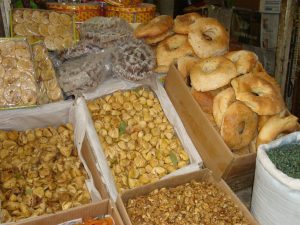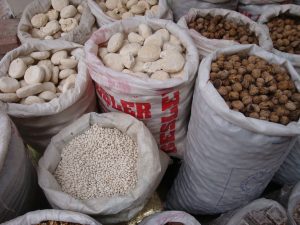Home to the büryan kebab Population: 161,300
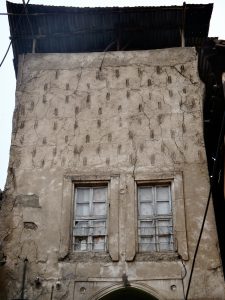 Siirt is one of those unlucky towns that has had much of its potential blighted by the south-eastern troubles of the last 30 years. Even today an outside visitor is as rare as snow in summer, and yet for the sort of adventurous traveller who regrets the appearance of a Starbucks on every street corner it’s the sort of town that has much to offer including an interesting local style of architecture, a lively market, and a cuisine all of its own.
Siirt is one of those unlucky towns that has had much of its potential blighted by the south-eastern troubles of the last 30 years. Even today an outside visitor is as rare as snow in summer, and yet for the sort of adventurous traveller who regrets the appearance of a Starbucks on every street corner it’s the sort of town that has much to offer including an interesting local style of architecture, a lively market, and a cuisine all of its own.
This is a very conservative part of the country. When I fell over in the town centre the mishap was greeted with consternation by the men (the only people on the street) who were reluctant to help me up again if it meant touching a strange woman. Fortunately, someone eventually overcame the taboo.
Don’t leave town without:
- trying melt-in-the-mouth büryan kebab and crispy perde pilav, a risotto with slithers of chicken and almonds baked in pastry
- buying a Siirt battaniye.
Around town
As the bus from Diyarbakır pulls into Siirt you pass a stranded monument: a 20th-century clocktower that incorporates the clockfaces from a 1905 version that eventually fell down.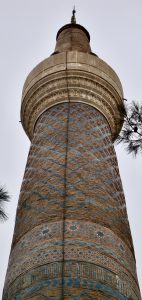
Siirt’s other best-known monument is also distinguished by its tower, in this case the minaret of the Ulu Cami (Great Mosque) that dates back to the 12th century when the Selçuks governed the area. The mosque itself, inconspicuously buried in a dip in the uphill Karakol district, is not especially exciting but the distinctive minaret is decorated with Kufic inscriptions and lovely turquoise tiles that give it a look of Central Asia (it’s reminiscent, too, of the riverside tomb at Hasankeyf which at one time held sway over Siirt). Restoration has given new life to the patterns on the minaret although sadly the end results don’t look as if they will be as durable as the originals.
It would be easy to run away with the idea that that was it as far as Siirt is concerned. However, if you divert into the cobbled back streets you will quickly realise that this was a town that was once full of beautiful two and three-storied houses created out of cas, a form of plaster made from locally-quarried gypsum that was slathered over stone-built shells. The finest of the houses were then given elaborately carved door and window frames, a few of which still survive.
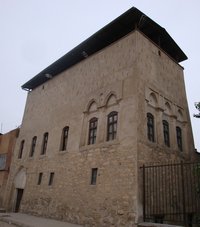 Internally, the cas evleri (plastered houses) were decorated with built-in niches, alcoves and soaring chimneybreasts. Externally they appear to have flat roofs although when you go inside you discover that some rooms actually harbour pretty domed ceilings.
Internally, the cas evleri (plastered houses) were decorated with built-in niches, alcoves and soaring chimneybreasts. Externally they appear to have flat roofs although when you go inside you discover that some rooms actually harbour pretty domed ceilings.
Cool in summer and warm in winter like the cave dwellings of Cappadocia, the houses were especially suited to the extreme local climate although they required regular maintenance to keep them watertight. The inevitable result is that no new cas houses are being built and those that do survive tend to be in a poor state of repair.
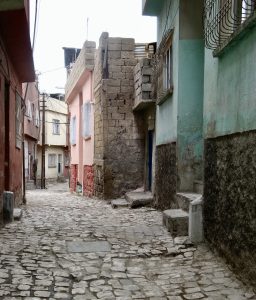
Conscious that the old houses are being swamped by a sea of concrete, the local authorities have restored and opened one particularly fine example with a small garden to the public. With simple mud-brick decoration on the outside and minimal furnishings inside, the house is much less spacious than it initially appears – – but then of course in high summer everyone would have been living in the garden or on the balcony anyway.
Going in search of the cas evleri is fun while the children are at school. At other times, however, a foreigner is likely to attract an entourage of youngsters demanding cash as unsolicited “guides”, some of them politely, some of them aggressively.
On the other hand you never know what else you may discover in the back streets. Turning one corner I bumped into a wandering minstrel, a Pied Piper of a figure with a rapt audience of children. As he passed their houses the neighbourhood women ran out and emptied whole boxes of sugar cubes into his sack as reward for its melodious efforts.
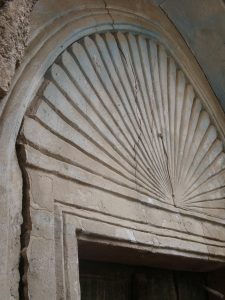 Back in the town centre the bazaar may not be quite as colourful as the famous one in Mardin although it’s well-stocked with plump locally-grown pomegranates, tasty local honeys and interesting local cheeses, not to mention lumps of dried yoghurt that resemble pumice stones and simit-like roundels of tandır ekmeği (bread baked in a tandır oven) that must be rehydrated before eating.
Back in the town centre the bazaar may not be quite as colourful as the famous one in Mardin although it’s well-stocked with plump locally-grown pomegranates, tasty local honeys and interesting local cheeses, not to mention lumps of dried yoghurt that resemble pumice stones and simit-like roundels of tandır ekmeği (bread baked in a tandır oven) that must be rehydrated before eating.
Here, too, you will still find craftsmen at work, in particular using traditional looms to create Siirt battaniye (Siirt blankets), rugs of undyed mohair that come in shades of black, beige, grey, cream and white. Small, light and inexpensive, they make perfect souvenirs but the locals also snap them up to serve as gifts or to advertise their businesses.
Less readily portable are the copper fez-shaped perde pilav pots that are designed especially for baking the local rice dish and come in all sorts of sizes. If you want to have a go at making the rice yourself be sure to look for one that has already been tinned, thereby making it safe for cooking.
Eating
How many of you are up for pit-baked lamb on thick pide bread first thing in the morning? And yet the surprising thing is that many Siirtlis apparently sit down to a hearty breakfast of büryan kebab while others of us are tucking into a bowl of muesli.
The pit-ovens used to make the kebab are fired up at six in the morning, at which time entire lamb carcasses are hung up inside them and the lids sealed with mud until they’re cooked through. Once a customer materialises a portion of lamb is sliced off, chopped into small pieces and sandwiched inside flaps of pide to be served with an onion and pepper.
Most of Siirt’s büryan kebab restaurants are unassuming little places where the tables are laid only with a sheet of paper. You wash down your meal with foaming ayran served in a bowl with a ladle. Leave it too late, though and you’ll be out of luck – – by 1pm it’s all over for the day and you’ll search for a büryan in vain.
It’s much harder to find the famed perde pilav in local restaurants. Unless you befriend a local and cadge a dinner invitation you’re unlikely to be able to sample this delicacy here.
Sleeping
Siirt has several small and very basic hotels that would be unsuitable for lone women travelers. The Barden Hotel probably offers the most comforts although the Erdef is more convenient if you just want to grab a bus in the morning and move on.
Barden Hotel. Tel: 0484-224 1111
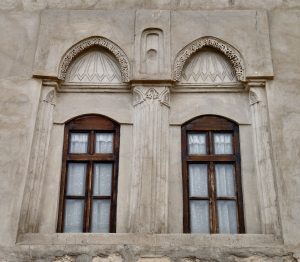 Transport info
Transport info
There are regular minibuses to Siirt from Diyarbakır’s İlce Garajı (Provincial Garage; to get there, take a local bus from Kıbris Caddesi, near the Dağ Kapısı). They will probably drop you near the Belediye in Siirt.
Returning to Diyarbakır you may find yourself dropped in the modern part of town whence you will need to take a local bus or taxi back to the old city if that’s where you’re staying.
There are onward buses from Siirt to Şırnak and Bitlis.
Taxi-dolmuşes to Tillo leave from in front of the Büyük Hotel in Siirt; they only leave when full although you can speed things up by paying for multiple seats.
Day trip destinations
